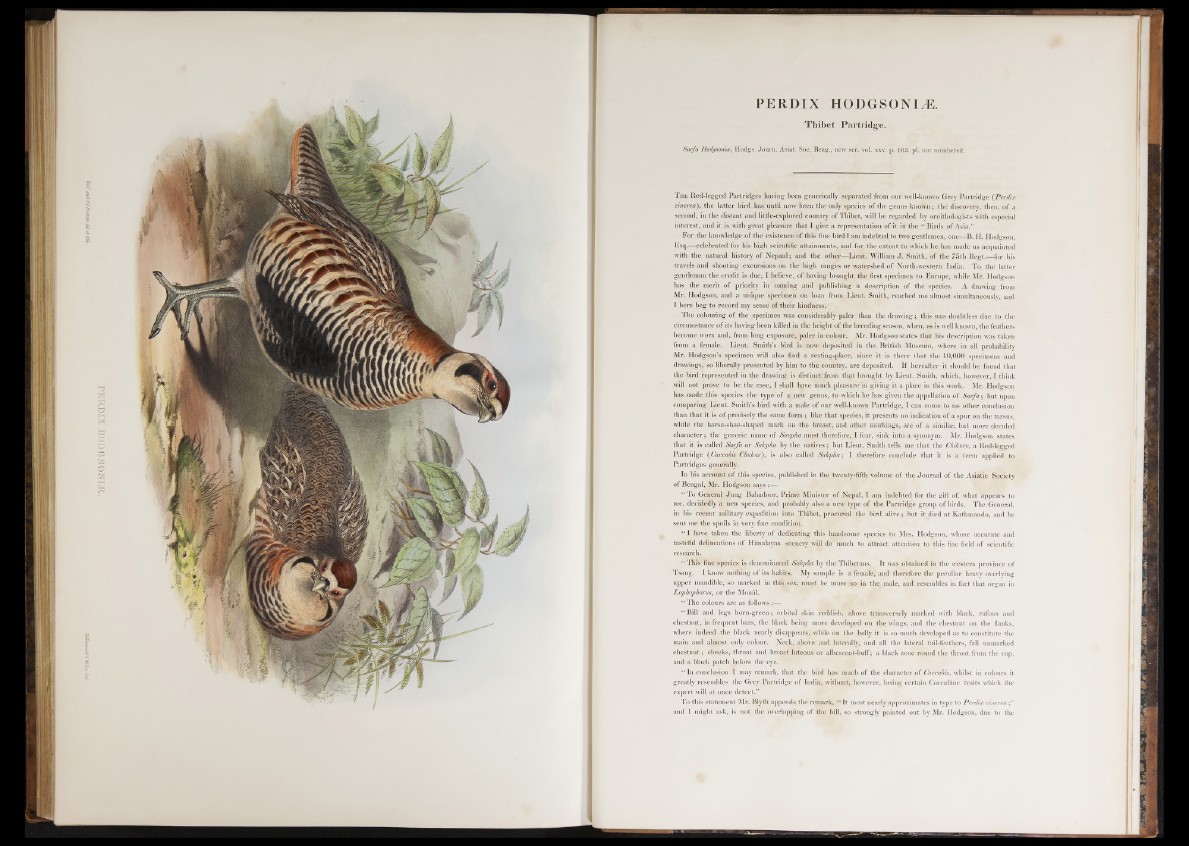
PERDIX HODGSONIiE.
Thibet Partridge.
Sac/a Hodgsonue, Hodgs. Joum. Asiat. Soc. Beng., new ser. vol. xxv. p, 165. pi. not numbered.
T he Red-legged Partridges having been generically separated from our well-known Grey Partridge {Perdice
cinered), the latter bird has until now been the only species of the genus known ; the discovery, then, o f a
second, in the distant and little-explored country of Thibet, will be regarded by ornithologists with especial
interest, and it is with great pleasure that I give a representation of it in the “ Birds of Asia.”
For the knowledge of the existence of this fine bird I am indebted to two gentlemen, one—B. H. Hodgson,
Esq.—celebrated for his high scientific attainments, and for the extent to which he has made us acquainted
with the natural history of Nepaul; and the other—Lieut. William J. Smith, of the 75th Regt.—for his
travelg and shooting excursions on the high ranges or watershed o f North-western India. To the latter
gentleman the credit is due, I believe, of having brought the first specimen to Europe, while Mr. Hodgson
has the merit o f priority in naming and publishing a description of the species. A drawing from
Mr. Hodgson, and a unique specimen on loan from Lieut. Smith, reached me almost simultaneously, and
I here beg to record my sense of their kindness.
The colouring of the specimen was considerably paler than the drawing; this was doubtless due to the
circumstance of its having been killed in the height o f the breeding season, when, as is well known, the feathers
become worn and, from long exposure, paler in*eolour. Mr. Hodgson-states that his description was taken
from a female. Lieut. Smith’s bird is now deposited in the British Museum, where in all probability
Mr. Hodgson’s specimen will also find a resting-place, since it is there that the 10,000 specimens and
drawings; so liberally presented by him to the country, are deposited. If hereafter it should be found that
the bird represented in the drawing is distinct from that brought by Lieut. Smith, which, however, I think
will not prove to be the case, I shall have much pleasure in giving it a place in this work. Mr. Hodgson
has made this species the type of a: new genus, to which he has given the appellation of Sacfa; but upon
comparing Lieut. Smith’s bird with a male of our well-known Partridge, I can come to no other conclusion
than that it is o f precisely the same form; like that species, it presents no indication o f a spur on the tarsus,
while the horse-shoe-shaped mark on the breast, and other markings, are of a similar, but more decided
character; the generic name o f Sacpha must therefore, I fear, sink into a synonym. Mr. Hodgson states
that it is called Sac/a or Sakpha by the natives; but Lieut. Smith tells me that the Chikore, a Red-legged
Partridge {Caccabis Chukar), is also called Sakpha; I therefore conclude that it is a term applied to
Partridges generally.
In his account of this species, published in the twenty-fifth volume of the Journal of the Asiatic Society
of Bengal, Mr. Hodgson says:—
“ To General Jung Bahadoor, Prime Minister of Nepal, I am indebted for the gift of, what appears to
me, decidedly a new species, and probably also a new type of the Partridge group of birds. The General,
in his recent military expedition into Thibet, procured the bird alive; but it died at Kathmandu, and he
sent me the spoils in very fine condition.
“ I have taken the liberty of dedicating this handsome species to Mrs. Hodgson, whose accurate and
tasteful delineations of Himalayan scenery will do much to attract attention to this fine field o f scientific
research.
“ This fine species is denominated Sakpha by the Thibetans. It was obtained in the western province of
Tsang. I know nothing of its habits. My sample is a female, and therefore the peculiar heavy overlying
upper mandible, so marked in this sex, must be more-so in the male, and resembles in fact that organ in
Lophophorus, or the Monal.
“ The colours are as follows:—
“ Bill and legs horn-green; orbital skin reddish, above transversely marked with black, rufous and
chestnut, in frequent bars, the black being more developed on the wings, and the chestnut on the flanks,
where indeed the black nearly disappears, while on the belly it is so much developed as to constitute the
main and almost only colour. Neck, above and laterally, and all the lateral tail-feathers, full unmarked
chestnut; cheeks, throat and breast luteous or albescent-buff; a black zone round the throat from the cap,
and a black patch before the eye.
“ In conclusion I may remark, that the bird has much o f the character of Caccabis, whilst in colours it
greatly resembles the Grey Partridge of India, without, however, losing certain Caccabine traits which the
expert will at once detect.”
To this statement Mr. Blyth appends the remark, “ It most nearly approximates in type to Perdix cinerea
and I might ask, is "not the overlapping of the bill, so strongly pointed out by Mr. Hodgson, due to the